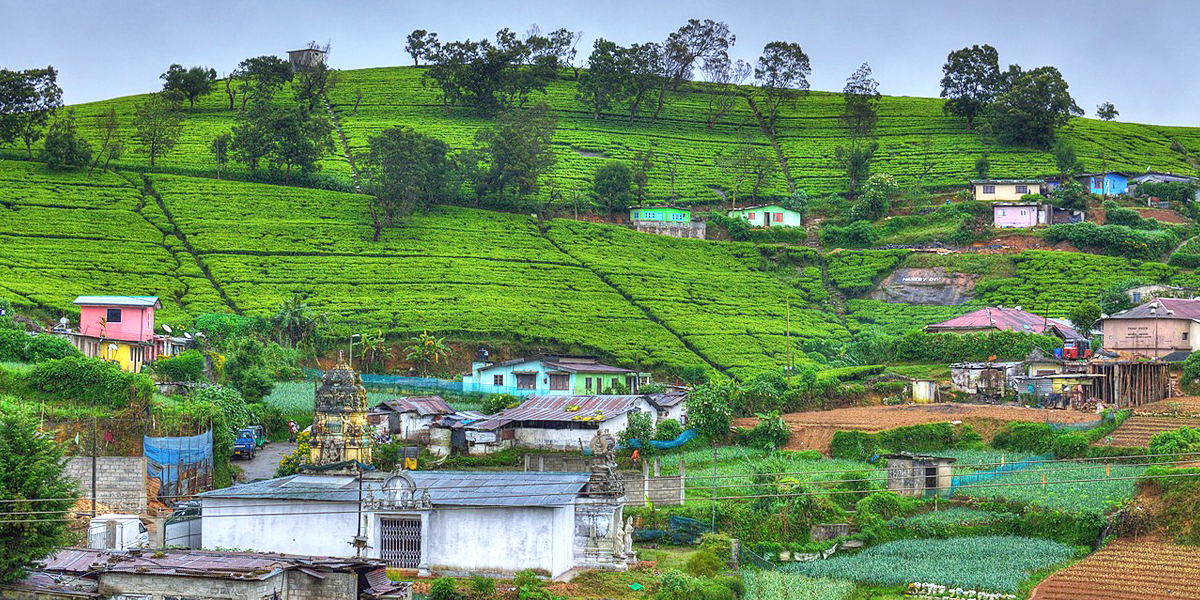Nuwara Eliya
The mountain city of Nuwara Eliya offers many different and exciting experiences that are bound to interest all types of travelers. Nuwara Eliya has a variety of attractions, mainly associated with its colonial past.


Treat your eyes to greenery by visiting Nuwara Eliya. It’s a serene hill station popular for its charming landscape and is an important location for tea production. It houses the best golf course in Sri Lanka and is home to the stunning Hakgala Botanical Gardens.
Nuwara Eliya, perched at an elevation of 1,868 metres in the central highlands of the country, is well known for its temperate climate, colonial history, and of course, for growing the best Ceylon Tea. Originally a simple town, it was completely transformed when colonial British officials incorporated the rustic landscape of the area to create ‘Little England’ – a quaint hamlet that resembled the English countryside.
The mountain town of Nuwara Eliya came into being when it was discovered by the British in the 19 th century. The British turned it into a quaint town, which mimicked life back in England. Much of the city’s history is therefore linked with events from the colonial era. However, like much of Sri Lanka, Nuwara Eliya too has a mythical past that is rather intriguing.
The Holy Trinity Church, consecrated in the year 1852, is a remnant of Nuwara Eliya’s colonial past. Located on Church Road, not too far from the Grand Hotel, the church is famed for its English village abbey feel. In fact, the church was also visited by Queen Elizabeth II and Prince Phillip, Duke of Edinburgh in 1954. The Royals were so smitten with the church’s quaint atmosphere, that they even donated a stained-glass window and a blue carpet.
The Victoria Park, located on the Nuwara Eliya - Uda Pussellawa Road, was built by the British in the year 1887 to commemorate the Diamond Jubilee celebration of Queen Victoria. The area started life as the research field of the nearby Hakgala Botanical Gardens, where the British used to test certain cash crops for mass cultivation. However, this soon changed and the park was built to resemble the sprawling gardens of English country manors. Couple that atmosphere with the sweet singing of endemic birds and fresh mountain air, and you are bound to feel that you have been immersed in an old English picture postcard.
Nuwara Eliya’s Lake Gregory, is an artificial lake reminiscent of the Serpentine in Hyde Park, United Kingdom. Constructed in 1873 during the governorship of Sir William Gregory, the lake was built primarily to aid power generation, but soon became a popular spot for recreational activities such as boating and fishing.
Today the lake and its surroundings have been re-developed by the Sri Lankan government and provide an ideal location for picnics, quiet strolls, pony rides or even a quick paddle in a swan boat available for rent.
The Pedro Tea Estate, established in 1885, is considered to be one of the first places in which the pioneer of the local tea industry, James Taylor perfected the art of growing Ceylon Tea. The estate is just about 3.5km away from the center of Nuwara Eliya.
Retrace the steps of the colonial pioneer while you walk through the tea bushes, learn the art of tea plucking and experience the process of how the famed tea brand comes to life. What makes this particular tea estate all the more enticing is that the manufacturing process remains true to orthodox methods which have been used for over a century. Once you are done with the plantation and factory visit, head over to the Lovers’ Leap Ethical Tea Boutique located right above the estate and enjoy a cup or two of hot tea while you enjoy the lush green view. Take note that the tea factory is closed between 12-2pm, so you will need to plan your visit around that.
If you are up for it, you could also head towards the resplendent Lover’s Leap Waterfall, accessible through the estate. Possessing an intriguing legend of how two lovers ended their lives by jumping into the abyss, it certainly does make for a great adventure.
The Seetha Amman Temple in Seetha Eliya, has been constructed in what is believed to be the last location Sita was held captive by Ravana. It is possibly the only temple in the world to be dedicated to Sita, and is extremely popular amongst the Hindu community, as well as tourists.
Nuwara Eliya is home to one of the oldest golf clubs in Asia. Built in 1889 by a Scotsman, the 18-hole golf course is ideal for both the amateur and pro golfer. Although full use of the club and its facilities requires membership, visitors can obtain a temporary membership which allows usage of the golf course and the club’s dining facilities. However, remember to call or email ahead and make a reservation to avoid disappointment. The Nuwara Eliya Golf Club, set amidst the resplendent landscapes of the central highlands of Sri Lanka, is still one of the premier golfing venues in Sri Lanka.
De Silva Food Centre – If you’re looking for food on a budget then head to the De Silva Food Centre. You’ll find a range of Sri Lankan and Chinese food available at very reasonable prices.
Milano Restaurant – Another budget option is Milano restaurant, which serves a mix of Sri Lankan, Chinese and Western meals. The service was quite slow during our visit but the food was good value for the price.
Grand Indian – Although this Indian restaurant is one of the most popular places to eat in Nuwara Eliya town, the prices are higher than most alternatives. Despite the cost, the food is of a high standard – so if you’re willing to splash out for a good meal then this is the place for you!
Grand Thai – Another of Nuwara Eliya’s most popular restaurants, serving a variety of tasty Thai dishes. It’s worth arriving early if you don’t want to wait for a seat at meal times!
Shopping in Nuwara Eliya highlights native retailers selling handicrafts, souvenirs, and other locally manufactured merchandise instead of imported or branded items. Most of the items sold are made by the local populace.
February to May is the best time to visit Nuwara Eliya; although the temperatures are quite low at this time, the city witnesses little rainfall, making it the perfect time for exploring the picturesque sights without worrying about the weather. April is quite a busy month in Nuwara Eliya, as this is the time of the Sinhalese New Year, with flower shows, horse races and car races happening across the city; inevitably, the prices at hotels often hit the roof in this month. The weather at Nuwara Eliya is relatively cold all through the year, with an average annual temperature of 15.9 °C. So, if you are planning your visit to Nuwara Eliya, don’t think much about the weather conditions. It is advisable to avoid the months of June to November, as the rainfall is generally high during this time, hindering sightseeing.
By flight
Nuwara Elia has no airports per se, but there are buses and cars available from Colombo in case tourists wish to avail of this option.
By road
Cars and taxis are also an option but traffic is very slow
By train
Kandy and Colombo is connected to this city via trains

Book with Us and Get Best Deals in
*Terms and Conditions applied